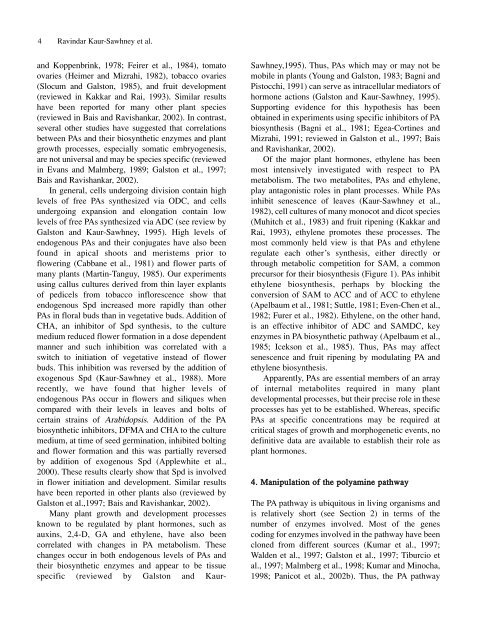(Converted)-4 - Journal of Cell and Molecular Biology - Haliç ...
(Converted)-4 - Journal of Cell and Molecular Biology - Haliç ...
(Converted)-4 - Journal of Cell and Molecular Biology - Haliç ...
Create successful ePaper yourself
Turn your PDF publications into a flip-book with our unique Google optimized e-Paper software.
4 Ravindar Kaur-Sawhney et al.<br />
<strong>and</strong> Koppenbrink, 1978; Feirer et al., 1984), tomato<br />
ovaries (Heimer <strong>and</strong> Mizrahi, 1982), tobacco ovaries<br />
(Slocum <strong>and</strong> Galston, 1985), <strong>and</strong> fruit development<br />
(reviewed in Kakkar <strong>and</strong> Rai, 1993). Similar results<br />
have been reported for many other plant species<br />
(reviewed in Bais <strong>and</strong> Ravishankar, 2002). In contrast,<br />
several other studies have suggested that correlations<br />
between PAs <strong>and</strong> their biosynthetic enzymes <strong>and</strong> plant<br />
growth processes, especially somatic embryogenesis,<br />
are not universal <strong>and</strong> may be species specific (reviewed<br />
in Evans <strong>and</strong> Malmberg, 1989; Galston et al., 1997;<br />
Bais <strong>and</strong> Ravishankar, 2002).<br />
In general, cells undergoing division contain high<br />
levels <strong>of</strong> free PAs synthesized via ODC, <strong>and</strong> cells<br />
undergoing expansion <strong>and</strong> elongation contain low<br />
levels <strong>of</strong> free PAs synthesized via ADC (see review by<br />
Galston <strong>and</strong> Kaur-Sawhney, 1995). High levels <strong>of</strong><br />
endogenous PAs <strong>and</strong> their conjugates have also been<br />
found in apical shoots <strong>and</strong> meristems prior to<br />
flowering (Cabbane et al., 1981) <strong>and</strong> flower parts <strong>of</strong><br />
many plants (Martin-Tanguy, 1985). Our experiments<br />
using callus cultures derived from thin layer explants<br />
<strong>of</strong> pedicels from tobacco inflorescence show that<br />
endogenous Spd increased more rapidly than other<br />
PAs in floral buds than in vegetative buds. Addition <strong>of</strong><br />
CHA, an inhibitor <strong>of</strong> Spd synthesis, to the culture<br />
medium reduced flower formation in a dose dependent<br />
manner <strong>and</strong> such inhibition was correlated with a<br />
switch to initiation <strong>of</strong> vegetative instead <strong>of</strong> flower<br />
buds. This inhibition was reversed by the addition <strong>of</strong><br />
exogenous Spd (Kaur-Sawhney et al., 1988). More<br />
recently, we have found that higher levels <strong>of</strong><br />
endogenous PAs occur in flowers <strong>and</strong> siliques when<br />
compared with their levels in leaves <strong>and</strong> bolts <strong>of</strong><br />
certain strains <strong>of</strong> Arabidopsis. Addition <strong>of</strong> the PA<br />
biosynthetic inhibitors, DFMA <strong>and</strong> CHA to the culture<br />
medium, at time <strong>of</strong> seed germination, inhibited bolting<br />
<strong>and</strong> flower formation <strong>and</strong> this was partially reversed<br />
by addition <strong>of</strong> exogenous Spd (Applewhite et al.,<br />
2000). These results clearly show that Spd is involved<br />
in flower initiation <strong>and</strong> development. Similar results<br />
have been reported in other plants also (reviewed by<br />
Galston et al.,1997; Bais <strong>and</strong> Ravishankar, 2002).<br />
Many plant growth <strong>and</strong> development processes<br />
known to be regulated by plant hormones, such as<br />
auxins, 2,4-D, GA <strong>and</strong> ethylene, have also been<br />
correlated with changes in PA metabolism. These<br />
changes occur in both endogenous levels <strong>of</strong> PAs <strong>and</strong><br />
their biosynthetic enzymes <strong>and</strong> appear to be tissue<br />
specific (reviewed by Galston <strong>and</strong> Kaur-<br />
Sawhney,1995). Thus, PAs which may or may not be<br />
mobile in plants (Young <strong>and</strong> Galston, 1983; Bagni <strong>and</strong><br />
Pistocchi, 1991) can serve as intracellular mediators <strong>of</strong><br />
hormone actions (Galston <strong>and</strong> Kaur-Sawhney, 1995).<br />
Supporting evidence for this hypothesis has been<br />
obtained in experiments using specific inhibitors <strong>of</strong> PA<br />
biosynthesis (Bagni et al., 1981; Egea-Cortines <strong>and</strong><br />
Mizrahi, 1991; reviewed in Galston et al., 1997; Bais<br />
<strong>and</strong> Ravishankar, 2002).<br />
Of the major plant hormones, ethylene has been<br />
most intensively investigated with respect to PA<br />
metabolism. The two metabolites, PAs <strong>and</strong> ethylene,<br />
play antagonistic roles in plant processes. While PAs<br />
inhibit senescence <strong>of</strong> leaves (Kaur-Sawhney et al.,<br />
1982), cell cultures <strong>of</strong> many monocot <strong>and</strong> dicot species<br />
(Muhitch et al., 1983) <strong>and</strong> fruit ripening (Kakkar <strong>and</strong><br />
Rai, 1993), ethylene promotes these processes. The<br />
most commonly held view is that PAs <strong>and</strong> ethylene<br />
regulate each other’s synthesis, either directly or<br />
through metabolic competition for SAM, a common<br />
precursor for their biosynthesis (Figure 1). PAs inhibit<br />
ethylene biosynthesis, perhaps by blocking the<br />
conversion <strong>of</strong> SAM to ACC <strong>and</strong> <strong>of</strong> ACC to ethylene<br />
(Apelbaum et al., 1981; Suttle, 1981; Even-Chen et al.,<br />
1982; Furer et al., 1982). Ethylene, on the other h<strong>and</strong>,<br />
is an effective inhibitor <strong>of</strong> ADC <strong>and</strong> SAMDC, key<br />
enzymes in PA biosynthetic pathway (Apelbaum et al.,<br />
1985; Icekson et al., 1985). Thus, PAs may affect<br />
senescence <strong>and</strong> fruit ripening by modulating PA <strong>and</strong><br />
ethylene biosynthesis.<br />
Apparently, PAs are essential members <strong>of</strong> an array<br />
<strong>of</strong> internal metabolites required in many plant<br />
developmental processes, but their precise role in these<br />
processes has yet to be established. Whereas, specific<br />
PAs at specific concentrations may be required at<br />
critical stages <strong>of</strong> growth <strong>and</strong> morphogenetic events, no<br />
definitive data are available to establish their role as<br />
plant hormones.<br />
4. Manipulation <strong>of</strong> the polyamine pathway<br />
The PA pathway is ubiquitous in living organisms <strong>and</strong><br />
is relatively short (see Section 2) in terms <strong>of</strong> the<br />
number <strong>of</strong> enzymes involved. Most <strong>of</strong> the genes<br />
coding for enzymes involved in the pathway have been<br />
cloned from different sources (Kumar et al., 1997;<br />
Walden et al., 1997; Galston et al., 1997; Tiburcio et<br />
al., 1997; Malmberg et al., 1998; Kumar <strong>and</strong> Minocha,<br />
1998; Panicot et al., 2002b). Thus, the PA pathway
















